Trudy J. Morgan-Cole's Blog, page 36
May 31, 2021
The Anthropocene Reviewed, by John Green
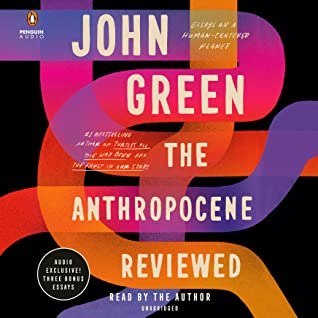
For much of the past year, one of the conversations I’ve had a few times, and seen other people have online, is: “Are we going to want to write/read about the pandemic, once it’s all over? Will there be great books about 2020, or will we just want to forget it all?”
I’ve now read two great books about 2020, and I’m going to tell you about both of them. This is the first.
The Anthropocene Reviewed is, on the surface, not a book about 2020. It’s a collection of essays, most of which appeared on a podcast that began airing in 2018. Its subjects — various aspects of our human-centred planet, minutely analyzed and rated on a five-star scale — range from ancient times to very recent history, but also touch on geography, anthropology, biology, and a lot of other -ologies. Its other subject, author John Green’s own life, ranges from 1977 to the present (and hopefully well beyond, but that’s outside the scope of this book). None of that content is specific to a modern-day Journal of the Plague Year, 2020/2021.
The premise of the book (and the podcast that preceded it) sounds like it could be merely silly, or merely intellectually interesting, but these essays are not merely anything. Whether Green is writing about the Lascaux cave paintings or about scratch-and-sniff stickers (only two of his many and varied topics), he is engaged in a practice of paying close attention — to who we are as humans, to how we have shaped and are shaping our planet, and also to his own experience with those things. Through the medium of exploring all these diverse places and things, he also explores being bullied as a child, adolescent friendships, falling in love, getting dumped, having a nervous breakdown, living with OCD, getting married, having children, and — oh yes — living through a global pandemic.
Although many of these pieces were written and pocasted in their original form before March 2020, the book was edited and found its final form in the Pandemic Times, and that awareness, while not present on every page, is certainly threaded throughout the collection of essays. Pieces that I remember hearing earlier on the podcast have been updated with thoughts that were on Green’s mind when he was shaping these essays into a book. One of the new essays (which I thought had been on the podcast because I know I’d heard Green talking about it earlier, but it was actually discussed in both a Vlogbrothers and an Art Assignment video — two of Green’s other projects — back in 2019) is about August Sander’s painting Three Farmers on Their Way to a Dance. It reflects on how this photograph was taken shortly before the outbreak of the First World War and how the young Germans in the famous photograph could not have known what awaited them in the next four years. Against this story, Green juxtaposes the memory of a photograph of his own — one of himself, his wife and some friends with a group of their children, the adults with arms around each other, the children in a tangle of play, taken in early 2020. We are reminded of how eerily a photograph freezes a moment in time, a moment when we don’t know what’s coming, what will happen to make that photograph unthinkable just a few months later.
These reflections on what it’s like to live through 2020 are sometimes glancing reflections; at other times, as with the story of the song “You’ll Never Walk Alone,” or the final piece (which exists only in the audiobook, not in the printed version of the book) about the smallpox vaccine, the COVID-19 context is integral to the piece. I’ve written elsewhere about how the podcast episode with “You’ll Never Walk Alone” is so integral to my memories of spring 2020, of coming out of lockdown here in St. John’s and listened to the podcast while walking my dog on the first truly summery day, crying uncontrollably.
There’s a lot of crying with this book, even with the pieces I’d heard before as podcast episodes. I don’t know if I would have cried as much reading the print book (which I also bought) as I did hearing the audiobook in John’s voice, but I couldn’t get through “You’ll Never Walk Alone” or “Googling Strangers” or “Auld Lang Syne” or several others without tears — however, there are also wryly funny moments, and insightful moments, and just weird moments. This is a book, in the broadest possible sense, about what it means to be human on this planet — and also what it means to be a very specific human living in a particular time and place, editing a book about being human in the middle of a global pandemic, wondering what hope means and where to find it. While John Green never set out to write a “pandemic book,” I’d argue he has written one of the definitive ones.
Just Like You, by Nick Hornby
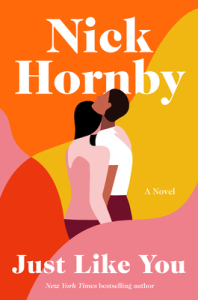
As always, Nick Hornby does not disappoint. I read Just Like You in a day and found it hard to put down. It’s the unlikely love story of Lucy, a middle-aged divorced English teacher and mother of two boys, and Joseph, nearly 20 years her junior, who initially is her sons’ babysitter but soon becomes much more.
There are plenty of differences between Lucy and Joseph — most obviously the 20-year age gap, which is always more shocking when the woman is the older one. There’s also a racial and cultural gap — Lucy is white; Joseph is Black. There’s a gap in their education and interests: Lucy is a teacher who loves books and the theatre, whose middle class friends are all voting to remain in the EU (the story begins in the summer before the Brexit vote, which is a recurring motif in the novel). Joseph, from a working class background, didn’t go to college, works a variety of low-paying jobs, and dreams of making it as a DJ. On the surface, they have nothing in common.
Yet Lucy and Joseph are powerfully attracted to each other, and are completely comfortable together. Where they’re not comfortable is any place outside Lucy’s house. Although attempts to socialize with Joseph’s family, with his friends, and with Lucy’s friends, all go better than either partner expects, there is no easy place for a couple as different as Lucy and Joseph to fit, and no clear path forward for their relationship.
In one of my own novels I had a character say that perhaps being with the right person doesn’t matter as much as being with someone who wants the same kind of life you do, and this is an idea that has always interested me — how much do common interest, goals, values and lifestyle weigh against romantic and sexual attraction, against the idea of “being in love”? It’s the central question of this novel: Lucy and Joseph are clearly in love, but do they belong together? Which matters more, in the end?
Another aspect of this novel that interested me is that we often talk these days about whether authors are “appropriating voice” when they write about characters whose race, gender, (dis)ability, etc, are significantly different from their own. Obviously writers can write whatever they want, but it’s also a reader’s prerogative to say, “This writer wrote in the voice of someone from my community, and frankly, I don’t feel like he did a great job.” Here, Hornby alternates points of view between a divorced woman who’s recently left an abusive marriage, and a young Black man from a working-class family. Both Lucy and Joseph have life experiences wildly different from Hornby’s own. I can’t judge how well he captured Joseph’s voice and point of view, but with Lucy, whose life experience is similar to mine in some aspects (at least being a middle-aged English teacher and mother, though not divorced from an abusive alcoholic), I feel like he captured her voice, her perspectives, and her worries very well. The whole book felt very believable and engaging to me.
Culture Warlords, by Talia Lavin

A book about white supremacists is never going to be a light, fun, or easy read, although Talia Lavin’s acerbic wit does make this journey into the dark side of the internet (and other places where white supremacists hang out) interesting and occasionally satirical. Lavin writes about various aspects of the alt-right and white supremacist movements and about her own experience infiltrating and catfishing white supremacists in order to expose them. Some of what she learns is chilling, but what’s most striking is the banality of evil — how boring and ordinary are these guys who want to kill Jews and keep the races segregated. And perhaps that’s the most chilling thing of all.
I’ve read critiques of this book that say that while the information Lavin presents is interesting, the format of the book is rambling and poorly organized, and maybe needed tighter editing with a more formal structure. This may be the case, but for me the audiobook format worked well because I was simply dipping into and out of her story, unable to handle too much hate and white nationalism at one sitting. For me the listening experience was a bit more like catching various episodes of a podcast rather than reading a book, so the structure/organization issue wasn’t as big a deal to me. Plus, Lavin reads it herself, and her actual speaking voice is such a good match for her writer “voice” that it was a great fit. Because of the subject matter, I can’t say I “enjoyed” this book, but I did learn a lot from it.
Katheryn Howard, the Scandalous Queen, and Katharine Parr, the Sixth Wife, by Alison Weir

These two books conclude Alison Weir’s “Six Tudor Queens” series on the wives of Henry VIII, the earlier volumes of which I have reviewed here and here. Weir’s competent handling of history in her turn from writing popular non-fiction to writing historical fiction continues here as she concludes the series. While she may not be as brilliant a novelist as some others who have written about the Tudor period, she is the only writer I know of to have dedicated a full-length, well-developed novel to each of Henry’s queens, following each woman’s life from childhood to death, and told each story in a way that makes that woman’s choices believable in the context of what we know about her and her time.
This is not always easy when a writer has to incorporate known historical facts and contemporary accounts into a fictional story and make a character’s actions seem justified (at least to the character herself). The difficult nature of this task is definitely on display in both these last two volumes. Katheryn Howard’s choices in her relationship with Thomas Culpepper while married to Henry, and Jane Boleyn’s role in that relationship, can seem very odd based on what we know; so can some of the things Katharine Parr is alleged to have said and done after Henry’s death, when she was married to Thomas Seymour (particularly in the incidents where Seymour was accused of flirting with and possibly sexually assaulting the young princess Elizabeth). Weir does the best she can to weave the historical record into a believable narrative, though in some cases the effort shows.
My only real complaint, having finished this series, is probably more with the publishers than with the author, and it is a trivial one: why was Katharine Parr’s book given such a terrible title? The others were The True Queen (Katherine of Aragon), A King’s Obsession (Anne Boleyn), The Haunted Queen (Jane Seymour), The Princess in the Portrait (Anna of Kleve), and The Scandalous Queen (Katheryn Howard). Why does poor Katharine Parr get essentially a number — The Sixth Wife — rather than a title that hints at anything about her personality, her marriage to Henry, or anything else? Even The Last Queen or The Queen Who Survived would have been better than The Sixth Wife. But having enjoyed the series, I guess it’s petty to quibble over titles. Still think Katharine Parr deserved better – she certainly deserved better than she got in life, and she deserved a better title too.
May 24, 2021
Revelations, by Mary Sharratt

This was a thoroughly enjoyable historical novel by Mary Sharratt, who has a real gift for taking the stories of very diverse women’s lives at different points in history and making them seem real and, if not relatable, at least comprehensible to a modern reader. Revelations is based on the life of medieval English mystic Margery Kempe, who had visions, left her husband and children to go on pilgrimages, and — unheard of for a fourteenth-century English woman — wrote a book, which was lost for many years and only discovered in the early 20th century by accident. She was a contemporary of Julian of Norwich and, in this story, is inspired by her brief meetings with the famous anchoress. But unlike Julian’s “showings,” Margery’s ecstatic visions brought her not into the cloistered life of a hermit, but out into the wider world she had always longed to see.
The novel is rich with fascinating detail, particularly about what it was like to go on a pilgrimage to Jerusalem (as well as to Rome and to Santiago di Compostella, other places Margery visited) at that time in history. While Margery’s world is wonderfully alien to us, the longing of a woman for a broader, more significant life feels absolutely genuine and believable. I really enjoyed this book.
The Constant Rabbit, by Jasper Fforde
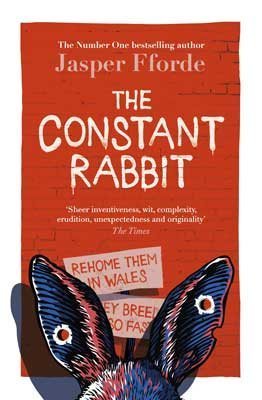
Jasper Fforde is back with another stand-alone novel. Unlike Early Riser, I didn’t find this one hard to get into at all — I was drawn in right away with the usual Fforde whimsy and charm. The premise of this novel (which I categorized here on the blog under “fantasy” because there’s really no category that fits a Jasper Fforde novel) is that several years ago, an inexplicable event caused a large number of animals around the world to become anthropomorphized. These animals are now roughly human sized, capable of human-like thought and speech, and generally behaving like — well, like talking animals in a children’s story, anthropomorphized but still having certain interests, skills and quirks typical of their species.
While several different animal species were affected by “the Event,” the largest population of anthropomorphized animals (because of how quickly they breed) is the rabbit population in England, which has grown fast enough to make up a significant element of society – 1.2 million rabbits — and, of course, to provoke an anti-rabbit backlash.
There’s a not-at-all-subtle parody here of anti-immigrant and anti-foreigner sentiment in today’s Britain, with the anti-rabbit political party being called UKARP and their goal being Rabexit — the expulsion of all rabbits from England. Fforde isn’t trying to be subtle — he’s having a lot of fun with a very entertaining premise while at the same time, writing a biting (or, at least, nibbling) satire centred around Peter Knox, a decent (human) man who doesn’t think he’s anti-rabbit at all, yet makes his living working for a government department that surveils and targets rabbits. Peter’s ability to turn a blind eye to the virulent anti-rabbit sentiment all around him is challenged when a rabbit family moves in next door — and the wife turns out to be his old college friend Connie.
The Constant Rabbit is a thoroughly enjoyable and thought-provoking read. It had a much more bittersweet ending than I normally expect from Jasper Fforde books, which left me a little bit sad, but it did seem like the right ending for that story.
The Company Daughters, by Samantha Rajaram
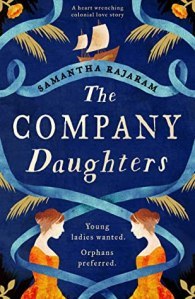
For me, The Company Daughters provided an intriguing glimpse into a world parallel to the one I’m exploring in my own current writing project. Set at about the same time as my own Cupids novels (early 17th century) this novel focuses on two young Dutch women who, lacking other options in life, become “Company Daughters,” sent out by the Dutch East India Company to marry settlers in Batavia (present-day Jakarta). Impoverished orphan Jana and her formerly-privileged mistress Sontje both end up on a seemingly endless voyage to the other side of the world, where marriages are quickly arranged for them. But though Jana begins the story wanting nothing more than food in her stomach, as her adventures unfold she discovers that she does have her own desires and dreams — but will life allow her to pursue them?
I enjoyed Jana as a character, and I really found it interesting to read about a colonial woman’s experience both similar to and different from the one I’ve been reading and writing about for the last few years.
May 23, 2021
Libertie, by Kaitlyn Greenridge
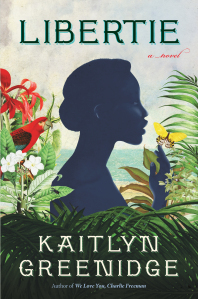
Like Sadeqa Johnson’s Yellow Wife, this book was interesting because it dealt with aspects of the lives of Black people in the United States during and after the time of slavery that I hadn’t known about before. The main character, Libertie, is the daughter of a Black woman physician in Brooklyn, New York around the time of the civil war — inspired by the real-life Susan Smith McKinney Steward, the first Black woman doctor in New York State. Libertie doesn’t share the light skin that allows her mother to be accepted non only by Black patients but by some white women as well; she takes after the dark-skinned Haitian father she never knew. She also doesn’t share her mother’s ambition to become a doctor, although her mother’s dream is that Libertie will practice medicine alongside her.
Libertie goes to college, but does poorly in her medical studies and is asked to leave, something she can’t bring herself to tell her mother. Instead, she marries her mother’s protegee, a young Black doctor from Haiti, and returns with him to his homeland, a land where free Black people rule their own nation. But her husband’s homeland, his family, maybe even her husband himself are not what Libertie expected.
It was intriguing to read about the rare opportunities that were available to an ambitious and well-connected Black woman like Libertie’s mother, and the real Susan Steward, as well as to read the part of the story set in Haiti and compare the experiences of Black people there to those in the United States. However, while the setting and subject of the story were fascinating, I found Libertie herself a hard character to get a handle on — I didn’t always find it easy to see what motivated her, or why she felt and acted as she did. I would have liked to have been full absorbed in this novel, but Libertie herself always kept me at arm’s length.
That Summer, by Jennifer Weiner

That Summer delivers everything I expect from a Jennifer Weiner novel: an engaging, believable, flawed heroine (two or possibly three in this book, actually), a complicated relationship and a conflict that tugs at the heartstrings, and a satisfying resolution. Daisy is in her 30s, married to a wealthy, successful man several years older than herself, parenting a difficult teenaged daughter and running her own small business when she meets Diana, a confident, successful, polished businesswoman who unexpectedly becomes her friend. By the time Daisy realizes that Diana is not everything she appears to be, she’s in too deep to turn back.
That’s one way to tell this story. Another way is to say it’s a story about “that summer” — about a fifteen-year-old girl’s encounter with an older boy on summer vacation, and how the end of that brief romance touches every aspect of that woman’s life for the next thirty years.
Here’s another way to tell it: this is a story about revenge. In this way, it’s strikingly similar to the last contemporary novel I read and loved, Joshilyn Jackson’s Mother May I. Both are about the consequences of an act of sexual assault committed by wealthy, privileged young men whose position in society virtually guarantees they will get away with it, that an indulgent world will look at them and say, “boys will be boys.” Both novels are about women who decide, years later, that they will get revenge for what happened to them. And both novels are also about women whose lives are turned upside-down by another woman’s desire for revenge, women who are forced to confront the reality that their lives may be built on foundations of lies.
The common thread — how can men be held accountable for “youthful indiscretions” that have thwarted women’s lives — ties these two novels together, although the tones are very different. While Mother May I has the tense, fast-paced thrum of a thriller, That Summer, though not without it twists and intrigue and suspense, has a slower, gentler pace, focusing more on the unlikely friendship between Diana and Daisy as they both confront the past sins of the man whose life has changed both of theirs. I found this a very enjoyable read.
May 19, 2021
My Year of Rest and Relaxation, by Ottessa Moshfegh
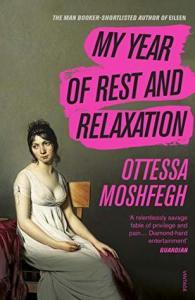
I read this book. It’s very highly acclaimed and I have a lot of thoughts about it. I can’t say I liked it, as such, but I’m glad I read it.
But am I going to type out all my thoughts about this book? No, because my daughter and I had a podcast conversation about this book (and about Normal People by Sally Rooney). If you want to know what I thought, listen to the podcast!



